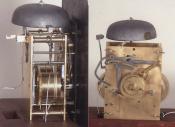Simon Willard of Roxbury, Massachusetts. A Willard tall clock for the bedroom.
This tall case clock was made by Simon Willard of Roxbury, Massachusetts.
This mahogany case is nicely proportioned. The case is constructed in mahogany and retains a wonderful modern finish that has been nicely maintained. It is a diminutive size standing only 7 feet 5.5 inches tall to the top of the center finial. The vast majority of Roxbury cases stand 7 feet 8 inches tall or greater. This example must have been custom ordered for a client with a ceiling height restriction. With the added feature of a silent \/ strike mechanism which is located on the dial, it is easy to speculate that it may have been manufactured to be place in the clients bedroom. This mechanism would allow one to turn off the strike train of the clock at will.
This case stands on nicely formed ogee bracket feet. They are applied to a double step molding. The waist section is long and narrow. It is fitted with a rectangular shaped door that is trimmed with an applied molding around the outer edge. This door is flanked by brass stop fluted quarter columns which terminate in brass quarter capitals. The bonnet features a traditional Roxbury style fretwork design. Three fluted chimney plinths support the three brass ball and spike finials. Fully turned and brass stop fluted bonnet columns are mounted in cast brass capitals and flank the bonnet door. This door is an arched form and it is fitted with glass. It opens to a colorfully painted iron dial. This dial is decorated with floral decorations in each of the four spandrel areas. Depicted in the arch of the dial, with in the oval, is a young woman who is seated at the edge of the forest reading a book. This dial is signed by the Clockmaker in script lettering. The time ring is formatted with Roman numeral hour markers. Arabic numerals are used to mark the five minute positions. Interestingly, this clock is lacking a subsidiary seconds dial. In it’s place is the silent \/ strike feature. This allows one to turn the striking portion of the clock on or off. This would be very practicable if one were to use this clock in or very near their bedroom. This might also explain the diminutive size of the case. A calendar dial can be viewed inside the time ring in it’s traditional location. The movement is brass and of good quality. It is weight powered and designed to run eight days on a full wind. It will also strike each hour on the hour on a cast iron bell. This bell is mounted above the movement.
This fine clock was made circa 1795.
Simon Willard was born in Grafton, Massachusetts, on April 3, 1753. He was the seventh of twelve children born to Benjamin Willard (1716-1775) and Sarah (Brooks) Willard (1717-1775) of Grafton. While living in Grafton, Simon answered the Lexington alarm on April 19, 1775, along with his brothers. It is thought that by 1782 he moved from Grafton and took up residence in Roxbury as a Clockmaker. Simon became a Master Clockmaker as well as an inventor. He is well known for receiving patents for his roasting jack in 1782, his "Improved Timepiece" or Banjo clock in 1802, and an alarm clock patent. In addition, he trained many men to make clocks who became well-known Clockmakers once their apprenticeships were served. Some of them include the brothers Levi and Able Hutchins, Elnathan Taber, William Cummens, Ezekiel Jones and Daniel Munroe. Some of the more notable public clocks Simon built include the clock in the United States Capitol building's Statuary Hall. He also built a clock for the House of Representatives and the U. S. Senate. Simon died on August 30, 1848, at the age of 95.




